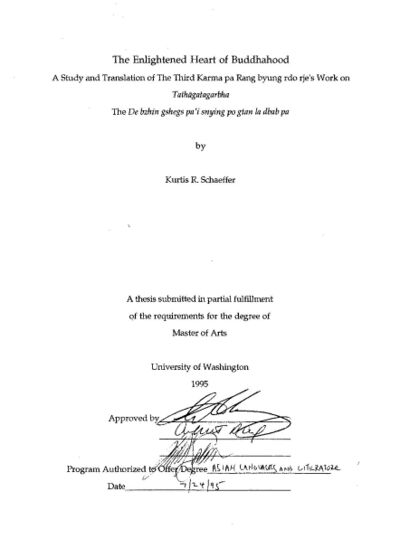The Enlightened Heart of Buddhahood
< Books
| (5 intermediate revisions by 3 users not shown) | |||
| Line 1: | Line 1: | ||
{{Book | {{Book | ||
| − | |||
|BookPerson={{Book-person | |BookPerson={{Book-person | ||
|PersonPage=Schaeffer, K. | |PersonPage=Schaeffer, K. | ||
| Line 9: | Line 8: | ||
}} | }} | ||
|FullTextRead=No | |FullTextRead=No | ||
| − | |BookEssay= | + | |BookEssay=The present work is a study of ''tathāgatagarbha'' (often referred to as Buddha Nature) thought, crystallized in a short text by one of the great religious scholars of fourteenth-century Tibet, the Third Zhwa nag Karma pa of the Bka' brgyud school, [[Rang byung rdo rje]] (1284-1339). This verse text, entitled "A Pronouncement on the Enlightened Heart of Buddhahood" (''De bzhin gshegs pa'i snying po gtan la dbab pa'', or ''De bzhin gshegs pa'i snying po bstan pa'') blends scriptural quotations from both ''sūtra'' and ''tantra'' with Rang byung's own words, creating an evocative picture of the relation between the primordially pure enlightened state- symbolized by the Enlightened Heart (''snying po'')- human existence, and Buddhahood. While Rang byung has relied heavily on the ''Ratnagotravibhāgaśāstra'', (known in Tibet as the ''Uttaratantra'', or ''Rgyud bla ma''), the syncretism of various strands of ''Mahāyāna'' and ''Vajrayāna'' apparent in the text is particular to Tibet. ''Tathāgatagarbha, Madhyamaka, Yogācāra, Mahāmudrā'', and ''Annuttarayogatantra'' all coalesce in this work, which is a testament to the hundreds of years of appropriation and synthesis of Indian and Tibetan Buddhist thought that preceded it. |
| − | The | + | The leitmotif of the ''Snying bstan'' is the indivisibility of the transcendent, |
| − | |||
| − | |||
| − | |||
| − | |||
| − | |||
| − | |||
absolute nature of reality and the immanent, ordinary human mode of reality. | absolute nature of reality and the immanent, ordinary human mode of reality. | ||
| − | This indivisibility is embodied in the concept of the Enlightened Heart (snying po). | + | This indivisibility is embodied in the concept of the Enlightened Heart (''snying po''). |
To paraphrase, it is precisely because all beings possess the Enlightened Heart of Buddhahood that they are, but for obscuring defilements, essentially Buddhas. | To paraphrase, it is precisely because all beings possess the Enlightened Heart of Buddhahood that they are, but for obscuring defilements, essentially Buddhas. | ||
| Line 38: | Line 31: | ||
Chapter three is a short discussion of the historical and doctrinal relation | Chapter three is a short discussion of the historical and doctrinal relation | ||
| − | between Rang byung and Dol po pa Shes rab rgyal mtshan (1292-1361), | + | between Rang byung and [[People/Dol_po_pa|Dol po pa Shes rab rgyal mtshan]] (1292-1361), |
generally recognized as the initiator of the gzhan stong (emptiness of other) | generally recognized as the initiator of the gzhan stong (emptiness of other) | ||
| − | system. While later Tibetan scholars such as 'Jam mgon Kong sprul blo 'gros | + | system. While later Tibetan scholars such as [[People/%27jam_mgon_kong_sprul|'Jam mgon Kong sprul blo 'gros mtha' yas]] (1813-1899) assimilate these two thinkers, referring to them both as |
| − | mtha' yas (1813-1899) assimilate these two thinkers, referring to them both as | ||
Gzhan stong pas, differences can be discerned in their thought. This chapter | Gzhan stong pas, differences can be discerned in their thought. This chapter | ||
merely begins to untangle a complicated relationship that will require a | merely begins to untangle a complicated relationship that will require a | ||
| Line 91: | Line 83: | ||
English The Pronouncement on the Enlightened Heart of Buddhism. | English The Pronouncement on the Enlightened Heart of Buddhism. | ||
| − | Finallly, chapter seven presents a diplomatic edition of the Snying bstan, as | + | Finallly, chapter seven presents a diplomatic edition of the Snying bstan, as well as the commentarial annotations to the text written by the fifth [[Zhwa dmar Dkon mchog yan lag]] (1525-1583), otherwise known as Dkon mchog 'bangs. (Schaeffer, introduction, 1–4) |
| − | well as the commentarial annotations to the text written by the fifth Zhwa dmar | ||
| − | Dkon mchog yan lag (1525-1583), otherwise known as Dkon mchog 'bangs. | ||
|BookToc=*{{i|Abbreviations| ii}} | |BookToc=*{{i|Abbreviations| ii}} | ||
*{{i|Introduction |1}} | *{{i|Introduction |1}} | ||
| Line 115: | Line 105: | ||
*{{i|Appendix Seven- Colophons from Rang byung mgur |183}} | *{{i|Appendix Seven- Colophons from Rang byung mgur |183}} | ||
|AddRelatedTab=No | |AddRelatedTab=No | ||
| + | |BookParentPage=Research/Secondary Sources | ||
}} | }} | ||
Latest revision as of 20:29, 20 May 2020
This thesis includes a translation of The Third Karmapa Rangjung Dorje's work on Tathāgatagarbha, the Pronouncement on the Enlightened Heart of Buddhahood (De bzhin gshegs pa'i snying po gtan la dbab pa) along with notes from the Fifth Shamar, Kongchog Yenlag (1525-1583). Kurtis Schaeffer analyzes the thought and language of the text and presents the key points cogently. Also included is a diplomatic edition of the Tibetan text in Wylie along with seven appendixes, including Jamgon Kongtrul's outline of Rangjung Dorje's text, a song on buddha-nature, and information from the Zab mo nang don related to the heart of Buddhahood.
| Citation | Schaeffer, Kurtis R. "The Enlightened Heart of Buddhahood: A Study and Translation of The Third Karma pa Rang byung rdo rje's Work on Tathāgatagarbha, The De bzhin gshegs pa'i snying po gtan la dbab pa." MA thesis, University of Washington, 1995. |
|---|---|

